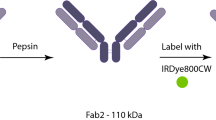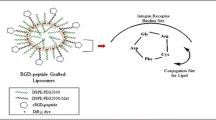Abstract
Purpose
Optical imaging would be desirable for cancer diagnostics since it can potentially resolve relevant oncological target structures in vivo. We therefore synthesised an αvβ3 targeted fluorochrome and imaged tumour xenografts with different αvβ3 expression levels using both planar and tomographic optical imaging methods.
Methods
An αvβ3-targeted RGD peptide was labelled with a cyanine dye (Cy 5.5). Binding of the optical tracer was tested on M21 melanoma (n = 5), HT-1080 fibrosarcoma (n = 6) and MCF-7 adenocarcinoma (n = 5) cells and their tumour xenografts. All optical imaging studies were performed using two-dimensional planar fluorescence reflectance imaging (FRI) technology and three-dimensional fluorescence-mediated tomography (FMT).
Results
In vitro, the peptide-dye conjugate showed a clear binding affinity to αvβ3-positive M21 and HT-1080 cells while αvβ3-negative MCF-7 cells and pre-dosing with the free RGD peptide revealed little to no fluorescence. In vivo, tumour xenografts were clearly visualised by FRI and FMT up to 24 h post injection. FMT allowed quantification of the fluorochrome distribution in deeper tissue sections showing an average fluorochrome concentration of 417.61 ± 105.82 nM Cy 5.5 (M21), 353.68 ± 54.02 nM Cy 5.5 (HT-1080) and 262.83 ± 155.36 nM Cy 5.5 (MCF-7) in the target tissue 60 min after tracer administration. Competition with the free RGD peptide resulted in a reduction in the fluorochrome concentration in M21 tumour tissue (294.35 ± 84.27 nM).
Conclusion
RGD-Cy 5.5 combined with novel tomographic optical imaging methods allows non-invasive imaging of tumour-associated αvβ3 expression and may thus be a promising strategy for sensitive evaluation of tumour target expression.






Similar content being viewed by others
References
Ntziachristos V, Bremer C, Graves EE, Ripoll J, Weissleder R. In vivo tomographic imaging of near-infrared fluorescent probes. Mol Imaging 2002;1:82–8.
Ntziachristos V, Tung CH, Bremer C, Weissleder R. Fluorescence molecular tomography resolves protease activity in vivo. Nat Med 2002;8:757–60.
Ntziachristos V, Yodh AG, Schnall M, Chance B. Concurrent MRI and diffuse optical tomography of breast after indocyanine green enhancement. Proc Natl Acad Sci USA 2000;97:2767–72.
Floery D, Helbich TH, Riedl CC, Jaromi S, Weber M, Leodolter S, et al. Characterization of benign and malignant breast lesions with computed tomography laser mammography (CTLM): initial experience. Invest Radiol 2005;40:328–35.
Felding-Habermann B, Mueller BM, Romerdahl CA, Cheresh DA. Involvement of integrin alpha V gene expression in human melanoma tumorigenicity. J Clin Invest 1992;89:2018–22.
Brooks PC, Clark RA, Cheresh DA. Requirement of vascular integrin alpha v beta 3 for angiogenesis. Science 1994;264:569–71.
Hodivala-Dilke KM, Reynolds AR, Reynolds LE. Integrins in angiogenesis: multitalented molecules in a balancing act. Cell Tissue Res 2003;314:131–44.
Jin H, Varner J. Integrins: roles in cancer development and as treatment targets. Br J Cancer 2004;90:561–5.
Felding-Habermann B, Fransvea E, O’Toole TE, Manzuk L, Faha B, Hensler M. Involvement of tumor cell integrin alpha v beta 3 in hematogenous metastasis of human melanoma cells. Clin Exp Metastasis 2002;19:427–36.
Cheresh DA, Spiro RC. Biosynthetic and functional properties of an Arg-Gly-Asp-directed receptor involved in human melanoma cell attachment to vitronectin, fibrinogen, and von Willebrand factor. J Biol Chem 1987;262:17703–11.
D’Souza SE, Ginsberg MH, Matsueda GR, Plow EF. A discrete sequence in a platelet integrin is involved in ligand recognition. Nature 1991;350:66–8.
Ruoslahti E, Pierschbacher MD. New perspectives in cell adhesion: RGD and integrins. Science 1987;238:491–7.
Montgomery AM, Becker JC, Siu CH, Lemmon VP, Cheresh DA, Pancook JD, et al. Human neural cell adhesion molecule L1 and rat homologue NILE are ligands for integrin alpha v beta 3. J Cell Biol 1996;132:475–85.
Montet X, Ntziachristos V, Grimm J, Weissleder R. Tomographic fluorescence mapping of tumor targets. Cancer Res 2005;65:6330–6.
Graves EE, Yessayan D, Turner G, Weissleder R, Ntziachristos V. Validation of in vivo fluorochrome concentrations measured using fluorescence molecular tomography. J Biomed Opt 2005;10:44019.
Ntziachristos V, Ripoll J, Wang LV, Weissleder R. Looking and listening to light: the evolution of whole-body photonic imaging. Nat Biotechnol 2005;23:313–20.
Haubner R, Bruchertseifer F, Bock M, Kessler H, Schwaiger M, Wester HJ. Synthesis and biological evaluation of a99mTc-labelled cyclic RGD peptide for imaging the alphavbeta3 expression. Nuklearmedizin 2004;43:26–32.
Mehta RJ, Diefenbach B, Brown A, Cullen E, Jonczyk A, Gussow D, et al. Transmembrane-truncated alphavbeta3 integrin retains high affinity for ligand binding: evidence for an ‘inside-out’ suppressor? Biochem J 1998;330 (Pt 2):861–9.
Haubner R, Wester HJ, Burkhart F, Senekowitsch-Schmidtke R, Weber W, Goodman SL, et al. Glycosylated RGD-containing peptides: tracer for tumor targeting and angiogenesis imaging with improved biokinetics. J Nucl Med 2001;42:326–36.
Beauvais DM, Burbach BJ, Rapraeger AC. The syndecan-1 ectodomain regulates alphavbeta3 integrin activity in human mammary carcinoma cells. J Cell Biol 2004;167:171–81.
Haubner R, Wester HJ, Reuning U, Senekowitsch-Schmidtke R, Diefenbach B, Kessler H, et al. Radiolabeled alpha(v)beta3 integrin antagonists: a new class of tracers for tumor targeting. J Nucl Med 1999;40:1061–71.
Haubner R, Weber WA, Beer AJ, Vabuliene E, Reim D, Sarbia M, et al. Noninvasive visualization of the activated alphavbeta3 integrin in cancer patients by positron emission tomography and [18F]galacto-RGD. PLoS Med 2005;2:e70.
Persigehl T, Heindel W, Bremer C. MR and optical approaches to molecular imaging. Abdom Imaging 2005;30:342–54.
Kessler T, Bieker R, Padro T, Schwoppe C, Persigehl T, Bremer C, et al. Inhibition of tumor growth by RGD peptide-directed delivery of truncated tissue factor to the tumor vasculature. Clin Cancer Res 2005;11:6317–24.
Haubner R, Wester HJ, Weber WA, Mang C, Ziegler SI, Goodman SL, et al. Noninvasive imaging of alpha(v)beta3 integrin expression using 18F-labeled RGD-containing glycopeptide and positron emission tomography. Cancer Res 2001;61:1781–5.
Janssen ML, Oyen WJ, Dijkgraaf I, Massuger LF, Frielink C, Edwards DS, et al. Tumor targeting with radiolabeled alpha(v)beta(3) integrin binding peptides in a nude mouse model. Cancer Res 2002;62:6146–51.
Chen X, Conti PS, Moats RA. In vivo near-infrared fluorescence imaging of integrin alphavbeta3 in brain tumor xenografts. Cancer Res 2004;64:8009–14.
Wang W, Ke S, Wu Q, Charnsangavej C, Gurfinkel M, Gelovani JG, et al. Near-infrared optical imaging of integrin alphavbeta3 in human tumor xenografts. Mol Imaging 2004;3:343–51.
Yamada T, Uyeda A, Kidera A, Kikuchi M. Functional analysis and modeling of a conformationally constrained Arg-Gly-Asp sequence inserted into human lysozyme. Biochemistry 1994;33:11678–83.
Colombo G, Curnis F, De Mori GM, Gasparri A, Longoni C, Sacchi A, et al. Structure-activity relationships of linear and cyclic peptides containing the NGR tumor-homing motif. J Biol Chem 2002;277:47891–97.
Chen X, Park R, Hou Y, Tohme M, Shahinian AH, Bading JR, et al. microPET and autoradiographic imaging of GRP receptor expression with 64Cu-DOTA-[Lys3]bombesin in human prostate adenocarcinoma xenografts. J Nucl Med 2004;45:1390–7.
Licha K, Riefke B, Ntziachristos V, Becker A, Chance B, Semmler W. Hydrophilic cyanine dyes as contrast agents for near-infrared tumor imaging: synthesis, photophysical properties and spectroscopic in vivo characterization. Photochem Photobiol 2000;72:392–8.
Haubner R, Wester HJ. Radiolabeled tracers for imaging of tumor angiogenesis and evaluation of anti-angiogenic therapies. Curr Pharm Des 2004;10:1439–55.
Chen X, Tohme M, Park R, Hou Y, Bading JR, Conti PS. Micro-PET imaging of alphavbeta3-integrin expression with 18F-labeled dimeric RGD peptide. Mol Imaging 2004;3:96–104.
Cheng Z, Wu Y, Xiong Z, Gambhir SS, Chen X. Near-infrared fluorescent RGD peptides for optical imaging of integrin alphavbeta3 expression in living mice. Bioconjug Chem 2005;16:1433–41.
Kircher MF, Mahmood U, King RS, Weissleder R, Josephson L. A multimodal nanoparticle for preoperative magnetic resonance imaging and intraoperative optical brain tumor delineation. Cancer Res 2003;63:8122–5.
De Grand AM, Frangioni JV. An operational near-infrared fluorescence imaging system prototype for large animal surgery. Technol Cancer Res Treat 2003;2:553–62.
Acknowledgements
We thank Wiebke Gottschlich and Ingrid Otto-Valk for their technical assistance. All animal studies were approved by the institutional review boards.
This work was supported in part by the DFG (BR 1653/2-1, SFB 656 project A4) and European Community (IP 6th framework; LSHG-CT-2003-503259).
Author information
Authors and Affiliations
Corresponding author
Rights and permissions
About this article
Cite this article
von Wallbrunn, A., Höltke, C., Zühlsdorf, M. et al. In vivo imaging of integrin ανβ3 expression using fluorescence-mediated tomography. Eur J Nucl Med Mol Imaging 34, 745–754 (2007). https://doi.org/10.1007/s00259-006-0269-1
Received:
Accepted:
Published:
Issue Date:
DOI: https://doi.org/10.1007/s00259-006-0269-1




